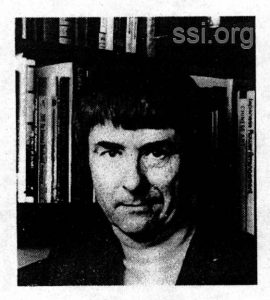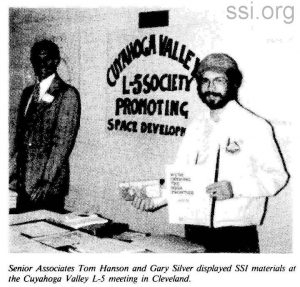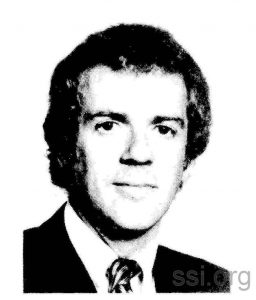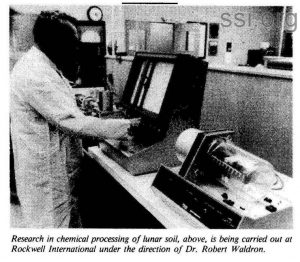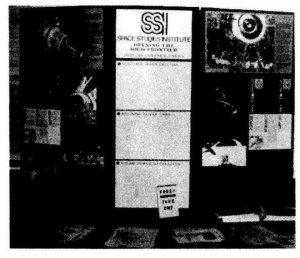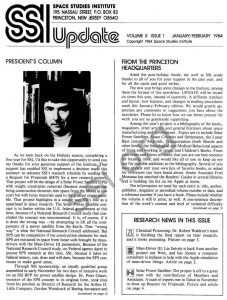
SSI UPDATE
SPACE STUDIES INSTITUTE
195 NASSAU STREET, P.O. BOX 82
PRINCETON, NJ 08540
[[librarian note: This address is here, as it was in the original printed newsletter, for historical reasons. It is no longer the physical address of SSI. For contributions, please see this page]]
VOLUME X ISSUE 1
JANUARY/FEBRUARY 1984
copyright 1984 Space Studies Institute
PRESIDENT’S COLUMN
As we look back on the Holiday season, completing a fine year for SSI, I’d like to take this opportunity to send you my thanks for your generous support of the Institute. That support has enabled SSI to implement a decision made this summer: to advance SSI’s research schedule by sending out a Request for Proposals (RFP) for a new research project. That project will be the design of a Solar Power Satellite (SPS) with weight constraints removed (because mass-drivers can bring construction elements into space from the Moon at low cost) but with lunar materials used to the greatest extent possible. That project highlights in a unique way SSI’s role as a spearhead in space research. The Solar Power Satellite concept is in limbo within the U.S. federal government at this time, because of a National Research Council study that concluded the concept was uneconomical. It is, of course, if it is done the wrong way – by attempting to lift all the components of a power satellite from the Earth. That “wrong way” is what the National Research Council addressed. But SPS can be competitive if the construction elements for each SPS are extracted in space from lunar soils brought by massdrivers with the Mass-Driver III parameters. Because of the National Research Council study, no Federal agency dares to pursue SPS research at this time. SSI, because it takes no federal money, can, does and will dare, because the SPS continues to make good sense.
Through SSI sponsorship, an ideally qualified group assembled in early November for two days of intensive work on an SSI RFP for power satellite design. Dr. Peter Glaser, inventor of the SPS concept in its original form, took time from his position as Director of Research for the Arthur D. Little Company. Gordon Woodcock of Boeing Aerospace and Ed Bock of Convair/General Dynamics took time from their project management positions. And Dr. John Freeman of Rice University contributed his expertise in solar energy conversion. Gregg Maryniak, Erin Medlicott and I, all from SSI, contributed all we could, Erin through both organization and through dedicated all-night typing sessions. The resulting RFP was a fine job, and went off on schedule. Your support makes it possible to initiate that new research. It is not an overstatement to say that if it is successful, you may honestly say that you played a direct and essential role in solving humanity’s energy problems on Earth for all time.
With deep appreciation for your continued generous support of the Institute, the entire staff joins me in wishing all of our Members and Associates a very happy, healthy and prosperous new year.
-Gerard K. O’Neill
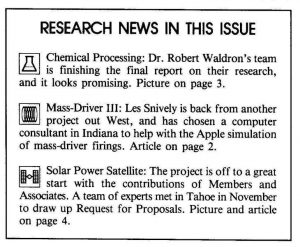
FROM THE PRINCETON HEADQUARTERS
Amid the post-holiday bustle, the staff at SSI sends thanks to all of you for your support in the past year, and for all the cards and good wishes.
The new year brings some changes to the Institute, among them the format of this newsletter. UPDATE will be issued six times this year, instead of quarterly. A different typeface and layout, new features, and changes in mailing procedures mark this January/February edition. We would greatly appreciate any comments or suggestions you have about the newsletter. Please let us know how we can better present the work you are so generously supporting.
Among this year’s projects is a bibliography of the books, magazines, other articles, and general literature about space manufacturing and development. Topics are to include Solar Power Satellites, Space Colonies and Settlements, the Lunar Base concept, Asteroids, Transportation (both Shuttle and other kinds), the Sociological and Medical/Behavioral aspects of living and working in space, and Children’s Books. From your notes and letters we know that you are our best resource for locating titles, and would like all of you to keep an eye out for possible additions to the bibliography. Several of you have already sent your own lists of favorite books, or asked for references you have heard about. Senior Associate Fred Montana has searched the Readers’ Guides in several libraries and is building the list on his Apple at home.
The information we need for each entry is: title, author, publisher, magazine or periodical volume number or date, and a reference number if you have a book. Please include whether the volume is still in print, as well. A one-sentence description of the work’s content and level of technical difficulty would also be of great help. Once the bibiliography is assembled, it will be available for a self-addressed envelope or a postage stamp. We’d like your entries as soon as possible, to have the bibliography completed by Spring.
Another project under consideration is the dissemination of SSI’s news in other countries, particularly in the Third World. Rashmi Mayur, President of the Global Futures Network and member of the Institute’s Advisory Board, met with the staff in December 1983 to discuss this idea.
As he pointed out, education is quite possibly the only way for a large portion of our planet’s population to overcome the serious economic, social and health problems it faces. A lack of relevent technology, crippling lack of resources in their own countries or the inability to exploit those resources, and ignorance keep people from contributing to their fullest potential. The wealth of energy and materials that will soon be available from space provides hope in a despairing environment.
Dr. Mayur has established an office in Bombay, India to distribute SSI materials throughout South America, Africa, India and Asia. The Institute is seeking an education grant to provide materials and postage for this effort.
With these and other new projects, along with our continued work on Mass-Driver, chemical processing and solar power satellites, SSI’s staff looks forward to sharing an exciting new year of progress with each of you. Best wishes for the new year from all of us.
Yes, Virginia, there is further mass-driver research being done here at SSI. Its local standard-bearer has been indisposed over the last few months which has hindered the pace of work getting done. But that block has been removed and new results will appear soon.
Our request for help with moving the MD III computer simulation from the Apple to a faster machine and language was answered by a number of very qualified SSI Members and Senior Associates. From those respondents we have asked Mark Senn, a computer consultant in the Chicago area, to have a try at getting the program to run in FORTRAN or Pascal on the Purdue University VAX l l/780s, CDC 6000s, and possibly even their Cyber 205. We have estimated that we will be able to increase the program execution speed by about 10,000 times if we were to use the Cyber 205. After we have a good version of the code running we will send copies of the source code to the other volunteers for their comments and suggestions.
As for the experimental work on the prototype, I hope to get back into the lab for a couple of weeks in January to turn up the power. With the rush and deadline of the Conference last May, we were not able to safely investigate and test the system at full power. When we get results from that work, I’ll report them to you here.
-Les Snively
Dr. Brian O’Leary is a long-time supporter of SSI. He is a former Apollo astronaut, an author and lecturer, and is now serving as an industrial consultant on advanced space concepts. On November 15, 1983, he presented a statement to the Senate Committee on Commerce, Science, and Transportation on the space station concept. This issue’s guest column is part of that statement.
I appreciate the opportunity to share with you some of my views on NASA’s proposed fiscal year 1985 new start on a permanently manned space station. Most of my life has been dedicated to the exploration of space. From the time I was eight years old and peered through a telescope at the planet Saturn, I have made it my vocation to research, write about and participate directly in mankind’s quest for a future beyond the Earth.
I envision a human renaissance in space during the 1990s. Not only are the steps leading to this technically possible and economically viable, but there is an unmistakable groundswell of interest, a yearning within many of us, to create a positive focus for humanity in space. These developments transcend the appearance that space is still the domain of the elite, the technocrats, or those who would rely on the internal logic that we can’t do it for this or that reason, or that must proceed on a linear path from A to B to C.
Outer space is a metaphor for human transcendence, for sparking an inner awareness of our potentials in a time of great peril, for accelerating our entry into the new age, for creating a spiritual unity among mankind.
The release of the movie THE RIGHT STUFF provides a catalyst to a renewed public awareness of the transcendent nature of space exploration. It is almost as though we have been drugged for nearly fifteen years (since the first Apollo lunar landing) into believing that these heroic qualities’ no longer exist. They do. And beyond that we have concepts that stagger the imagination. Even President Reagan has recently asked NASA to become more visionary.
Like the Renaissance on Earth five hundred years ago, the renaissance in space will require whole new perspectives and an ability to transcend and confront the unexpected. Our dreams about the future in space are well-documented in books and magazine articles, but the unanticipated twists remain to be experienced.
There will be delays, time for others to catch up with us, time to gestate the new perspective that will allow to experience the forthcoming renaissance in space. Since the days of Apollo the excitement of the human adventure in space has been put on hold. It is popular to focus on the here-and-now, the provable, the tentative linear extrapolations into the future. But the vision remains, and the larger view is shared by a diverse and growing community of people both inside and outside the space program.
Two extreme models of the space station come to mind. On the one hand we could envision it as a sterile, grey, antiseptic barracks-like place where the presence of people is incidental to the engineering tasks at hand, where the astronauts themselves live lives of regimented blandness, high stress, carrying out an endless checklist of preprogrammed tasks, and otherwise existing in the unrewarding life of some frontier outpost.
On the other hand, we could envision space station residents as people who view the beauty of the Earth beneath them with a sense of the oneness of mankind, who are on a quest for new vision, and who still complete the tasks at hand. Indications of the onset of the space renaissance suggest that our space station of the 1990s will reflect a more positive view, that it will facilitate bringing out the best in us.
And if it doesn’t turn out that way immediately, it will later on. In his book Disturbing the Universe, Freeman Dyson predicts that groups of highly motivated people bound by common spiritual purpose will be the first to colonize space. They may not necessarily be qualified by bureaucratic standards, but they will make the journey in spite of what governments plan to do.
He describes a scenario in which these people populate an asteroid and use its resources to sustain and support them. He estimated that, as a fraction of the Gross National Product and in terms of human risk, the investment in the first bold journey to an asteroid would be smaller than that of the Pilgrims’ voyage aboard the Mayflower and the first Mormon settlement of Utah. In both historical cases, the groups were not the adventuresome macho male explorers we see on new frontiers, but “ordinary” people with a strong sense of mission and purpose.
Like the first settlers in new frontiers on our planet, the first settlers of the High Frontier(sm) of space will be men, women and children with a strong spiritual identity (though not necessarily religious in the sense of following established structures), a willingness to try out a new way of life, and a desire to transcend the old paradigms of living. Many of these people may be on the first space station, the way station to the first human colonies in space. This raises the question, who will inhabit the space station as it grows during the 1990s?
The answer is speculative, but it is likely that the space station. will at first be a governmental operation and will evolve into a commercial center that would begin to take in the new breed of people analogous to the Pilgrims and Mormons.
We will need scientists aboard the station with strong intuitive minds in a productive working and living environment. Those scientists will need a maximum of flexibility in using their intelligence in designing their experiments with a minimum of pre-programming, overtasking, and single-path approaches. They should be stocked with plenty of spare parts for repairs and necessary changes. The creative environment should be stressed. This user-friendly approach is a part of the new perspective which separates the space station from previous space missions.
These considerations lead to a final point: that the space station must provide comfortable accommodations to its users. Standardized full-sized modules that would fit in a Shuttle cargo bay are most cost-effective for the volume provided. The interiors should be aesthetically pleasing, with plenty of room for crew members to express their individuality and creativity. The best industrial and academic scientists will not be attracted to working in a barracks or sardine factory for months at a time.
We need to stay away from historical precedents as much as possible. The space station is not a nuclear submarine, an Antarctic outpost, a Spartan military installation, an Apollo capsule, or even a Skylab (which had a lot more room than even a full-sized space station habitability module will provide). The space station is a unique concept that should be designed flexibly enough to allow for an expended 1990s technology and lifestyle, not a 1960s programmatic planning approach Freeman Dyson warns about. To liken the space station to earlier facilities may be defeating its own purpose of being a place for conducting the best possible research and development.
Fortunately we still have the opportunity to design a space station that will meet these criteria at a cost that would differ negligibly from a more antiseptic approach. We will need to bring in a broader community of people to participate in the design, program planning and operation of the station.
With an investment during the late 1980s of one thousandth of the federal budget, the space station probably has more leverage on the future than any other single project undertaken by the United States. It provides an opportunity for us to move ahead in a timely way, to leave open our long-term options in space with both technology and manpower now at hand. To turn back now, to close the door or to postpone well beyond 1990 the option of building a base camp in space would be (unforgivably) short-sighted.
The human zest for exploring, for doing the seemingly impossible, has a long history of which Apollo was one example. We have a golden opportunity in 1992 to commemorate the 500th anniversary of the New World by exploring new worlds beyond the Earth.
An SSI-sponsored conference was held in South Lake Tahoe, California, October 31 through November 1 to prepare a Request for Proposals (RFP) to design a Solar Power Satellite constructed of lunar materials.
Participants in the conference included Edward Bock, aerospace engineer, San Diego; John Freeman, professor of space physics and astronomy at Rice University, Houston; Peter Glaser, Vice-President of Arthur D. Little Co., Cambridge; Gregg Maryniak, Executive Vice-President of Space Studies Institute, Chicago; Erin Medlicott, Secretary of the Board of SSI, Princeton; Gerard O’Neill, President of SSI, Princeton; and Gordon Woodcock, aerospace engineer, Seattle.
“The use of nonterrestrial resources could help to meet the requirements of the global population in the 21st century,” said Dr. Glaser, who is known for his work on the SPS concept during the late 1960s. “If these resources are not employed, the peoples’ insistent demands for improvement in living standards may be very difficult to meet.”
Power from one satellite could replace the power from ten average-sized nuclear plants. A single satellite could provide enough power for any major city in the United States. Each SPS would collect light from the sun and safely transmit it to the Earth in the form of useable energy. Its saleable value, in 1983 dollars, is estimated at $10 billion.
The RFP was sent to aerospace companies and universities in November. Deadline at SSI for receipt of incoming proposals is January 9, 1984. A committee of scientists and engineers will review the proposals and select a contractor to perform the study.
If you are interested in a copy of the Request for Proposals, call or write the SSI Princeton office.
LOCAL SUPPORT TEAM NEWS
BOSTON AREA: On December 1, 1983, Peter Diamandis and his crew presented a workshop for interested people in the Boston area. Forty people attended, among them several current Members and Senior Associates. A slide presentation and viewing of SSI’s videotape brought in several new Members. The Boston area is off to a busy start.
FLORIDA AREA: Book sales, regional meetings, several new Members and Senior Associates mark a vigorous effort by Team Leader Steve Morgan. At the end of November presentations were made at the Florida Institute of Technology, to groups of graduate students and the Astronomy Society.
SAN DIEGO AREA: We apologize for several mistakes in the information printed in the last issue of UPDATE, listing Jim Bowery as coordinator for Los Angeles. Terry Savage is serving as that area’s leader, while Jim is heading the San Diego group. His corrected telephone number is xxx-xxx-xxxx. Jim has sent several reports of the activities in his part of California, attended by some of John Sievers’ class on space colonization at San Diego State University.
CINCINNATI AREA: Pictured below is an SSI display board constructed by Senior Associate Robert Brodbeck for Dr. O’Neill’s evening speaking engagement at Xavier University in Cincinnati October 12. Permission from XU to have the display and arrangements for it were made with the assistance of SSI Member and XU Physics professor Dr. John Hart. Over 150 SSI brochures and “Opening the High Frontier”(sm) flyers were taken from the table by lecture attendees before and after Dr. O’Neill’s talk. SSI supporter Sam Marshall gave help in having the SSI brochures reproduced for the occasion. Bob Brodbeck plans to use the display board in coming months in his work as Ohio Team Leader, such as at the talk he gave to the Columbus, Ohio Mensa Society on November 12.
BOOKS AND LECTURES
“The Technology Edge: Opportunities for America in World Competition,” by Gerard O’Neill, is scheduled for release in mid-February, 1984. Published by Simon and Schuster, the book sells for $16.95.
Dr. O’Neill’s lecture schedule for Spring 1984 is as follows. We expect to make additions as soon as they have been finalized. (* indicates a lecture closed to the public.)
*April 2, 1984: IBM-Belgium, held in Madrid, Spain.
April 10, 1984: The Lawrenceville School, Lawrenceville, New Jersey.
SSI SPECIAL MEMBERSHIP ITEMS
Here is a list of SSI items for sale. Please feel free to photocopy this page if you need additional order forms. To order, complete the form at the bottom of the page and mail it with your check or money order in U.S. funds to Space Studies Institute.
SLIDE SET: A set of sixteen color slides and descriptions of space colonies and space manufacturing. Included are artists’ renderings of the “Island One” colony, a crew members’ living quarters and office. plant and animal agricultural areas. a mass-driver under construction, and asteroid mining. Set of 16 for $15.00.
WINDOW STICKER: Blue and white sticker of SSI logo and address adheres to car window. $1.00 each.
LAPEL PIN: Gold and black cloisonné pin with “tie Tack” back. A handsome gift. $5.00 each.
BOOKS: Copies of Dr. O’Neill’s book 2081 A Hopeful View of the Human Future in hardcover edition is available for $13.95. The High Frontier is available in paperback for $8.95. All books are sent by Book Rate. so allow 2-3 weeks for delivery.
GIFT SUBSCRIPTIONS: An attractive personalized gift card announces your gift subscription for a friend or relative For each gift, enclose the name to be placed on the card. and the address where it should be sent along with your donation of $15.00, $25.00 or $50.00.
I wish to support the research and education programs of SSI for one year as a:
[ ] Sponsor ($200-$500)
[ ] Donor ($50)
[ ] Sustaining Member ($15)
[ ] Patron ($100)
[ ] Contributor ($25)
[ ] This is a renewal.
[ ] New address.
[ ] YES, I understand the importance of expanding SSI’s Membership base. The lnstitute’s work is critical and you need the support of more concerned people to keep at it.
[ ] I’ve done my part. Here are checks or money orders from ___ new SSI Members, all of whom have joined with at least a $15.00 donation. __
[ ] Here’s my special gift of $____ for the Solar Power Satellite design study.
[ ] YES! I would like to give EXTRA support for Mass-Driver III. Here’s my check for $___
[ ] I want to be one of the First Thousand. Send me Senior Associate information today.
Name:
Address:
City, State, ZIP:
Send with check or money order ta SSI, 195 Nassau Street Princeton, New Jersey 08540
[[librarian note: This address is here, as it was in the original printed newsletter, for historical reasons. It is no longer the physical address of SSI. For contributions, please see this page]]
– ALL DONATIONS ARE TAX DEDUCTIBLE
©space studies institute

